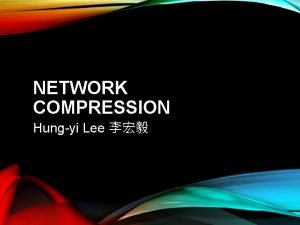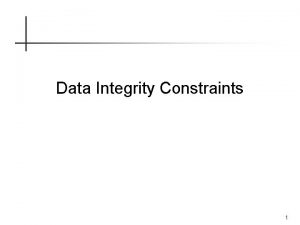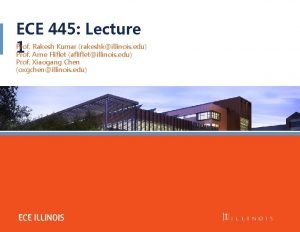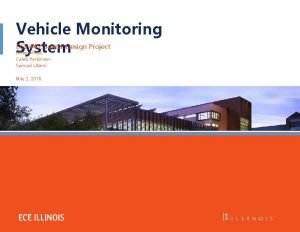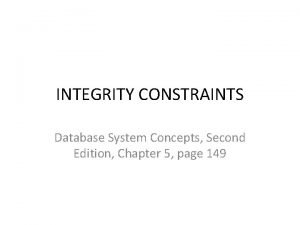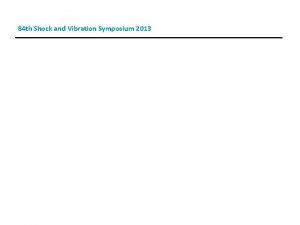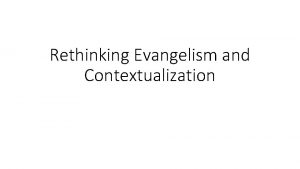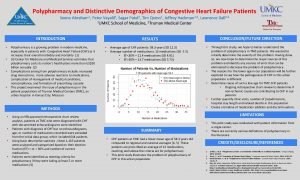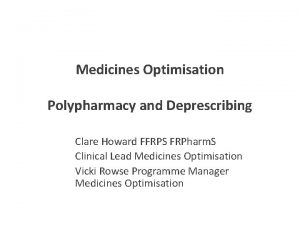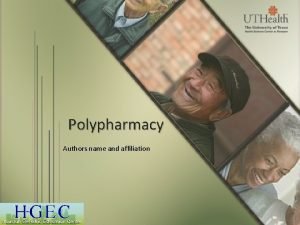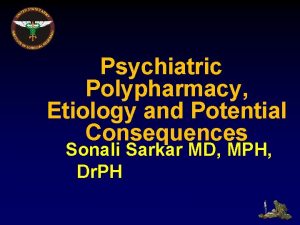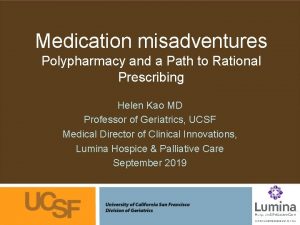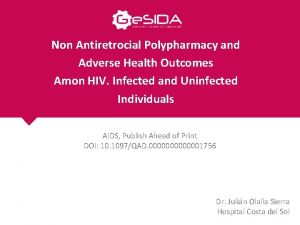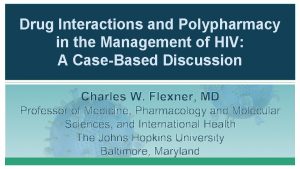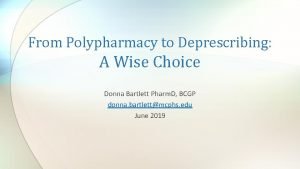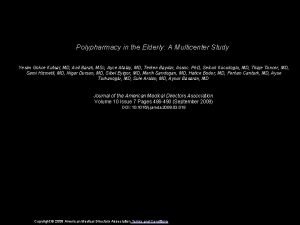Symposium 445 THE WAR AGAINST POLYPHARMACY RETHINKING AND




















































- Slides: 52

Symposium #: 445 THE WAR AGAINST POLYPHARMACY RETHINKING AND RE-EVALUTION NEEDED FOR EACH AND EVERY DRUG IN THE ELDERLY CHAIR: DORON GARFINKEL, ISRAEL SPEAKERS: JOHN ELLERSHAW, LIVERPOOL, UK THIERRY CHRISTEANCE, GHENT, BELGIUM DEE MANGIN, CHRISTCHURCH, NEW ZEALAND DORON GARFINKEL, PARDES-HANA, ISRAEL

Symposium #: 445 THE WAR AGAINST POLYPHARMACY RETHINKING AND RE-EVALUTION NEEDED FOR EACH AND EVERY DRUG IN THE ELDERLY INTRODUCTION DORON GARFINKEL, M. D. HEAD, GERIATRIC PALIATIVE DEPARTMENT SHOHAM GERIATRIC MEDICAL CENTER PARDES – HANA, ISRAEL

THE “BAD SIDE” OF AGING: AGE-RELATED DISEASES & DISFUNCTIONS T HE ATHEROSCLEROSIS C A N CB ER D E M EA ND TIA(. ) D R SDIEDP R E S S I O N E IMPAIRED IMMUNITY -> INFECTIONS U O OSTEOPOROSIS & OSTEOARTHROSIS, F F ALLS – IHD. & CHF, CVA, PVD & RENAL MOST TYPES ALZHEIMER’S DIS G S DIABETES MELLITUS, PARKINSON’S DISEASE CATARACT, GLAUCOMA, AMD, HEARING LOSS, PROSTATIC HYPERTROPHY, INCONTINENCE, PRESSURE SORES. . . BED RIDDEN


POLYPHARMACY. . . preferably defined as : “The administration of more medications than are clinically indicated” “Inappropriate Medication Use” (IMU) medication use that has more potential risk for harming than potential benefit, is less effective or most costly than alternatives available. . . or does not agree with accepted medical standards. Hanlon et al. Suboptimal prescribing in older inpatients & outpatients. J Am Geriatr Soc 2001; 49: 200 -9.

Inappropriate Medication Use (IMU) Extent of the Problem 44000 - 98000 Americans Die Each Year Secondary to Medical Mistakes. . Vehicle Accidents 43460 Breast Cancer 42300 Deaths/year Institute of Medicine (IOM) Report, 1999: To Err Is Human: Building a Safer Health Care System

EXTENT OF THE PROBLEM THE ELDERLY IN . . . Use 3 TIMES the number of medications. . . Consume OVER ONE THIRD of the prescription & nonprescription medications used in the US The RISK OF HOSPITALIZATION secondary to IMU outcomes in elderly patients is estimated at 17% Almost 6 TIMES GREATER than that for the general population Lombardi & Kennicutt. Pharmacists (1), 2001 Nananda C et al, Medscape Arch Int Med 1990; 2 150: 841 -6.

EXTENT OF IMU IN NURSING HOMES The total number of prescriptions correlates with the increase number of IMU 1 Patients receive an average of 6 Over 20% receiving > 10 medications daily 2 1). Liu GG GG & & Dale BC. J J Am Am Pharm Assoc 2002; 42 42 (6): 847 -57. . 2). Bernabei R, et al. J Gerontol Series A 1999; 54: M 25 -33.

DRUG DISTRIBUTION

PALLIATIVE CARE - WHEN TO START? P R E S E N T A T I O N CURATIVE & LIFE PROLONGING THERAPY D E A DISEASE QUAL ITY OF LIFE > >> T H Relieve suffering (Palliative, Hospice)

B I R T H PALLIATIVE PERCEPTION – WHEN TO APPLY? P R E S E N T A T I O N THE CURRENT MODEL CURATIVE & PREVENTIVE THERAPY HEALTH DISEASE THE SUGGESTED MODEL HEALTH ONLY D I S E A SPALLIATIVE E PALLIATIVE – QOL & RELIEVING SUFFER D E A T H

THE “REAL-LIFE” MODEL IN MOST ELDERLY PEOPLE HEALTH DISEASE 1 ONLY PALLIATIVE QU ONLY D IA SEASE 2 PALLIATIVE L > > ITY ONLY > O DISEASE> 3 F PALLIATIVE > > LIF E > > DISEASE 4 D E A T H ONLY >. . PALLIATIVE THE COMPLEX IMPACT OF CO-MORBIDITY

EXCEPT ~10%“BAD WHO EXPERIENCE SUDDEN DEATHTHE OF AGING: PREVENTIVE & SIDE” CURATIVE MEANS AGE-RELATED DISEASES & DISFUNCTIONS PALLIATIVE THERAPY IN ALL ! IN MOST AGE RELATED DISORDERS ATHEROSCLEROSIS – IHD. & CHF, CVA, PVD & RENAL CANCER - MOST TYPES DEMENTIA (ALZHEIMER’S DIS. ) DEPRESSION THE IMPAIREDB IMMUNITY AD -> INFECTIONS OSTEOPOROSIS FALLS D R & OSTEOARTHROSIS, SID E DIABETES MELLITUS, PARKINSON’S DISEASE U O CATARACT, GLAUCOMA, AMD, HEARINGFLOSS, G S PROSTATIC HYPERTROPHY, INCONTINENCE, PRESSURE SORES. . . BED RIDDEN

William Shakespeare, As You Like It, 2. 7 “And so from hour to hour we ripe and ripe, and then GUSTAV VIGELAND GARDENS, OSLO from hour to hour We Can we rot and rot; Improve the and thereby hangs a tale. “

HOW DO WE DIE ? ? ? Nowadays, very few adults / elders die suddenly while apparently healthy; most experience time-related increased number of incurable co-morbidities, disability and suffering for increasingly prolonged periods of time before death.

AFTER AGING. . . ”GET SICK AND DIE”, which once covered no more than a few weeks, Now often goes on for YEARS The USUAL “END OF LIFE” has come to be LIFE WITH SERIOUS CHRONIC ILLNESS FOR A LONG TIME. . . . Lynn J & Cretin S. Editorial, J Am Ger Soc 2000; 48: 1017 - 8.

HEALTH – DISEASE PERCEPTION IN THE 21 TH CENTURY 100 % GOOD HEALTH & LIFE QUALITY UA LITY BA D Q OF L IF E TIME IN LIFE BAD QOL . WHICH ONE IS WORSE? DEATH D YD IENAGT. . . H

DRUG THERAPY – THE HISTORIC 20 TH CENTURY CHANGE EBM MEANS OF PREVENTION (DRUGS & OTHER) REPRESENT THE MOST COST EFFECTIVE INTERVENTIONS TO PROMOTE HEALTH & QOL, DELAY DISEASES & COMPLICATIONS, DELAY & COMPRESS SUFFERING & DISABILITY, INTO A SHORTER END OF LIFE PERIOD BEFORE DEATH. DO WE ACTUALLY ACHIEVE THIS GOAL IN MOST PEOPLE?

MEDICATION GUIDELINES – WE KNOW WHEN TO START DRUGS DO WE KNOW WHEN TO STOP ? WHY DO PHYSICIANS CONTINUE TO GIVE PREVENTIVE & CURATIVE MEDICATIONS OCCASIONALLY UNTILL DEATH ? WHY ARE PHYSICIANS, BEING AWARE OF POLYPHARMACY / IMU RELUCTANT TO DISCONTINUE MANY DRUGS ?

WHY DON’T WE STOP DRUGS ? ? ? Drugs are often given to elders based on Clinical Practice Guidelines (CPGs) that extrapolate evidence of benefit in younger adults without significant co-morbidity, who have a life expectancy of several decades. Physicians usually EXTRAPOLATE from these CPGs to include all elders, Even Those with MULTIPLE CO-MORBIDITIES, SEVERE DISABILITY, DEMENTIA & even “TERMINAL” PATIENTS

Clinical practice guidelines (CPGs) and quality of care for older patients with multiple comorbide diseases. PR IMU M Adhering to current CPGs in elders with several co-morbidities may have undesirable effects; basing standards for quality of care and pay-for-performance on existing CPGs could lead to inappropriate judgment of the care provided, Create perverse incentives that emphasize the wrong aspects of care for this population and diminish the quality of their care NO N N OC ER E! Boyd CM, Darer J, Boult C, et al. J Am Med Ass 2008; 294: 716 – 24.

PRINCIPLES OF DRUG THERAPY – THE 21 TH CENTURY ENLIGHTMENT Ø DO WE HAVE TO CONTINUE ALL CURATIVE AND PREVENTIVE MEDICATIONS UNTILL DEATH? Ø ARE THEY STILL COST EFFECTIVE, HAVING POSITIVE BENEFIT / RISK RATIO : IN A VERY ADVANCED AGE ? Ø IN THE PRESENCE OF SEVERE CO-MORBIDITY? DISABILITY? DEMENTIA ? Ø IN THE PRESENCE OF SIGNIFICANT SUFFERING ? Ø IN THE PRESENCE OF LIMITED LIFE EXPECTANCY ? THERE ARE NO GOOD EVIDENCE BASED ANSWERS !

PALLIATIVE PERCEPTION – P A WHETHER / WHEN TO STOP DRUGS? ? L B I R T H P R E S E N T A T I O CURAT I VE, LIFE E X T E ND I NG DRU P R E V E N T I V E ME D I C GS A T I O N S N HEALTH DISEASES LD I E A TA I T VH E O N L Y TILL WHEN? ? ASPIRIN, WARFARIN, DIPIRIDAMOLE, STATINES, β BLOCKERS, ACE / ARI, CALCIUM CHANNEL BLOCKERS, NITRATES, DIURETICS, OMEPRAZOLE, H 2 BLOCKERS, BENZODIAZEPINES, TCI & OTHER ANTIDEPRESSENTS, IRON, SALTS AND VITAMIN SUPPLEMENTATIONS. . . TILL WHEN? ?

. . . NO ONE WOULD SUGGEST CONTINUATION OF PREVENTIVE & CURATIVE GUIDELINES

GERIATRIC-PALLIATIVE PERCEPTION – P A L L I CURAT I VE, LIF A E EXTE NDI NG THERAPT P RE V E NT I V E T HE R AP Y IY V E P A THE “REVERSED EXTRAPOLATION” METHOD WHETHER / WHEN TO STOP DRUGS? ? L B I R T H P R E S E N T A T I O N HEALTH DISEASES ONLY L I A T I V E D E A T H O N L Y ASPIRIN, WARFARIN, DIPIRIDAMOLE, STATINES, β BLOCKERS, ACE / ARI, CALCIUM CHANNEL BLOCKERS, NITRATES, DIURETICS, OMEPRAZOLE, H 2 BLOCKERS, BENZODIAZEPINES, TCI & OTHER ANTIDEPRESSENTS, IRON, SALTS AND VITAMIN SUPPLEMENTATIONS. . . TILL WHEN? ?

SUMMARIZING THE PROBLEM FOR MOST CURATIVE / PREVENTIVE MEDICATIONS 1). The Positive Benefit / Risk Ratio is Decreasing or Non - Exsistant In Correlation to Age, Multiple Co-Morbidities, Disability, Dementia & Quality of Life . 2). The extent of Drug Related Problems and IMU is Increasing In Correlation to Age, Co-Morbidities, Disability, Dementia and the Number of Drugs Consumed (Polypharmacy) being particularly disturbing in LTC departments

THE WAR AGAINST POLYPHARMACY THE “REVERSED EXTRAPOLATION” METHOD CURATI VE, LIFE EXTEND ING ? ? ? P RE V E NT I V E T HE RA PY ? ? ? HEALTH ? YEARS CO-MORBIDITIES < << D E A T H TO GIVE ? PALLIATIVE OR NOT ONLY TO GIVE? TIME < < MONTHS << WEEKS << DAYS. . . HOURS. . . BEFORE DEATH REVERSED EXTRAPOLATION (TIME BEFORE DEATH. . . ) REVERSED EXTRAPOLATION - TYPE OF PATIENTS INDEPENDENT ELDERS << COMMUNITY FRAIL ELDERS << DISABILITY / DEMETIA

THE WAR AGAINST POLYPHARMACY A NEW GERIATRIC-PALLIATIVE APPROACH IN THE COMMUNITY AND IN LONG TERM CARE FACILITIES DORON GARFINKEL, M. D. HEAD, GERIATRIC PALIATIVE DEPARTMENT SHOHAM GERIATRIC MEDICAL CENTER PARDES – HANA, ISRAEL

THE WAR AGAINST POLYPHARMACY THE “REVERSED EXTRAPOLATION” METHOD IN LONG TERM CARE FACILITIES CURATI VE, LIFE EXTEND P RE V E NT I V E ING ? ? ? T HE RAP Y ? ? ? HEALTH ? YEARS CO-MORBIDITIES < << D E A T H TO GIVE ? PALLIATIVE OR NOT ONLY TO GIVE? TIME < < MONTHS << WEEKS << DAYS. . . HOURS. . . BEFORE DEATH REVERSED EXTRAPOLATION (TIME BEFORE DEATH. . . ) REVERSED EXTRAPOLATION - TYPE OF PATIENTS INDEPENDENT ELDERS << COMMUNITY FRAIL ELDERS << DISABILITY / DEMENTIA

THE WAR AGAINST POLYPHARMACY A NEW GERIATRIC-PALLIATIVE APPROACH IN LONG TERM CARE FACILITIES METHODS & PATIENTS Individualization of drug therapy was started in 180 elderly patients who were hospitalized in 6, out of the 10 nursing departments at the Shoham Geriatric Center In each patient, an attempt was made TO STOP ALL DRUGS for which THERE WAS NO CLEAR CUT INDICATION, and / or REDUCE THE DOSAGE of drugs for which the indication was still relevant

THE WAR AGAINST POLYPHARMACY A NEW GERIATRIC-PALLIATIVE APPROACH IN LONG TERM CARE FACILITIES METHODS & PATIENTS ATTEMPTS TO STOP/REDUCE DOSE WERE MADE FOR: NITRATES IN ALL ASYMPTOMATIC PATIENTS DRUGS FOR HTn GRADUALLY WITH STRICT MONITORING DIURETICS NO CLEAR SYMPTOMS/SIGNS OF CHF EXIST ANTIACIDS & H 2 BLOCKERS IN ALL ASYMPTOMATIC PATIENTS SEDATIVES & TRANQUILIZERS ANTI DEPRESSANTS, PSYCHOTROPIC DRUGS PENTOXIFYLLINE, DIPYRIDAMOLE, NSAIDs, MISCELLANEOUS: SLOW K, SLOW FE, ORAL HYPOGLYCEMICS CHOLESTEROL LOWERING, ASPIRIN, ANTI EPILEPTICS, MINERALS, VITAMINS. .

THE WAR AGAINST POLYPHARMACY IN LONG TERM CARE FACILITIES METHODS & PATIENTS The control group was composed of patients of the same 6 departments in whom discontinuation of drugs (DD) have not been performed. The study & control groups were treated by the same interdisciplinary teams who regarded DD in some patients as part of an overall clinical policy attempting to improve drug therapy. None of the team members was aware of our intention to evaluate the long term outcomes of patients in whom DD have/have not been performed.

DEMOGRAPHY and CO-MORBIDITIES Parameter Study Group Control Group P - Value Total Number Female/Male A G E (Mean ±S. D) Dementia * Double Incontinence Indwelling Urinary Catheter Hypertension Congestive Heart Failure 119 71 - 32/87 81. 2 ± 8. 3 112 (94%) 111 (93%) 21 (18%) 55 (46%) 12 (10%) 44/27 82 ± 8. 7 66 (93%) 66 (92%) 10 (14%) 29 (41%) 5 (7%) NS @ NS + NS NS NS Previous Myocardial Infarction Chronic Atrial Fibrillation Diabetes Mellitus COPD Previous Stroke - CVA Hypo Albuminemia ** Recurrent Infections # 6 (5%) 16 (13%) 36 (30%) 6 (5%) 45 (38%) 29 (24%) 35 (29%) 9 (13%) 14 (20%) 17 (24%) 9 (13%) 28 (39%) (25%) 18 13 (18%) NS NS @ + * ** Not significant. All parameters except Age, were analyzed employing the Chi square test t - test Mini Mental State Examination (MMSE) 14/30 or less Serum albumin < 3. 0 g/dl

Annual Success Rate According to the No. Drugs Discontinued In Nursing Departments No. Drugs Discontinued Rate of Failure - No. Patients Re administration No. of Patients Drugs 7 2 2/2 3/14 6 4 2/4 5/24 5 13 5/13 13/65 4 15 5/60 3 29 4/29 5/87 2 26 1/52 1 30 2/30 TOTAL 119 21/119 33/332 PERCENT 100 18 10

Annual Success Rate According to Types of Drugs Discontinued DRUG NITRATES No. Pts. Stopped 22 Reccurence of Symptoms/Signs 0 % of Success. 100 H 2 BLOCKERS 35 2 94 ANTI HTn 51 9 82 DIURETICS (fusid) 27 (25) 4 (4) 85 PENTOXIFYLLINE 15 0 100 SLOW K 20 0 100 SLOW FE 19 1 95 SEDAT & TRANQUIL 16 2 88 ANTIDEPRESSANTS 19 5 74 ANTIPSYCHOTICS 13 4 69

Annual Rate of Deaths Study Group Control Group Total No. 119 71 Deaths 25 (21%) 45%)) 32 P - Value 0. 001

Annual Rate of Deaths and Referrals to Acute Care Facilities Study Group Control Group P - Value Total No. 119 71 Deaths 25 (21%) 45%)) 32 0. 001 Referrals to Acute Care Facilities 14 (11. 8%) 30%))21 0. 002

The Average Daily Cost of Drugs per Patient in US dollars * ** P Value 1 – 6 / 2003 1 – 6 / 2004 Control group No 2 * 4)Wards( 1. 39 0. 07 **Study Departments 6)Wards( 1. 74 1. 28 0. 02 1. 65 FOUR DEPARTMENTS (132 Patients) in which our new therapeutic approach was not applied. SIX DEPARTMENTS (198 Patients) in which our new therapeutic approach was applied. The figure represents cost of drugs of 119 patients of the study group + that of patients in whom no change in drugs was made.

Conclusions Application of the Good Palliative-Geriatric Practice (GPGP) methodology in disabled elders enables simultaneous discontinuation of several medications and yields several benefits: reduction in mortality rates & referrals to acute care facilities, lower costs and improved quality of living.


POLYPHARMACY Inappropriate Medication Use (IMU) medication use that has more potential risk for harming than potential benefit. . .

At least in Nursing Departments, the Sum Total of Negative Impacts of MEDICATIONS, OUTWEIGHS the Sum Total of the Potential Beneficial Effects of all specific drugs.

THE WAR ON POLYPHARMACY : A New, Cost Effective, Geriatric - Palliative Approach for Improving Drug Therapy in Disabled Elderly People DORON GARFINKEL, SARAH ZUR-GIL, JOSHUA BEN-ISRAEL MEDICAL ASSOCIATION JOURNAL (IMAJ) 9: 430 - 4 (June 2007)

THE WAR AGAINST POLYPHARMACY THE “REVERSED EXTRAPOLATION” METHOD IN LONG TERM CARE FACILITY CURATI VE, LIFE EXTEND ING ? ? ? P RE V E NT I V E T HE RA PY ? ? ? HEALTH ? YEARS CO-MORBIDITIES < << D E A T H TO GIVE ? PALLIATIVE OR NOT ONLY TO GIVE? TIME < < MONTHS << WEEKS << DAYS. . . HOURS. . . BEFORE DEATH REVERSED EXTRAPOLATION (TIME BEFORE DEATH. . . ) REVERSED EXTRAPOLATION - TYPE OF PATIENTS INDEPENDENT ELDERS << COMMUNITY FRAIL ELDERS << DISABILITY / DEMETIA

THE “REVERSED EXTRAPOLATION” METHOD IN COMMUNITY DWELLING ELDERS CURATIVE, LIFE EXTEN DING TX. P RE V E NT I V E T HE RA PY HEALTH DISEASES ? MANY YEARS < TO GIVE ? PALLIATIVE OR NOT ONLY TO GIVE? D E A T H TIME BEFORE < YEARS< < MONTHS << WEEKS < DAYS. HOURS. . . DEATH TIME BEFORE DEATH. . . ) TYPE OF PATIENTS IN THE COMMUNITY INDEPENDENT ELDERS << FRAIL ELDERS << DISABILITY / DEMETIA

THE WAR AGAINST POLYPHARMACY : IN COMMUNITY DWELLING ELDERLY PEOPLE PRELIMINARY RESULTS 70 elders, mean age 82. 8 ± 7, 92% independent / frail. 94% suffered ≥ 3, 51% > 6 different health problems (co-morbidities). Mean Follow Up 19. 2 ± 11 months. Elders used 7. 73 ± 3. 7 drugs (range 0 -16). DD recommended for 57. 5% (4. 4 ± 2. 5 drugs/elder) of all drugs 47% (3. 7± 2. 5 drugs/elder) actually stopped. Only 5/256 DD had to be readministered (failure 2%) successful DD eventually achieved in 80. 7%. No significant adverse effects 80% of Patients/Families reported medical - functional - mental cognitive improvement, defined as significant in 37%, outstanding in 29%. 10 elders (14%) died, mean age at death 88 years, FU 13 ± 9 months.

THE WAR AGAINST POLYPHARMACY : APPLYING THE GPGP APPROACH IN THE COMMUNITY Application of the GPGP methodology was executed in several dozens of community dwelling elders. DRUG DISCONTINUATION could be performed in almost all of them (1 – 9 drugs) with no significant adverse effects. In some, a remarkable improvement was noticed in the quality of life: improvement in mobility, alertness and cognitive status (e. g. an increase in mini mental state examination [MMSE] from 14/30 to 30/30 in two months)

THE GPGP APROACH – WHEN/IF TO STOP MEDICATIONS The decision is based on clinical common sense and should be taken together with the patient & family. An attempt should be made to be less aggressive in reaching rigid target goals (Blood Pressure, serum glucose & lipid levels), while giving more room to QUALITY of LIFE and PATIENT / FAMILY preferences.

Primum non nocere Individualization Autonomy Advance Directives Patient / family preferences The Sum Total of all negative Impacts of potential beneficial Polypharmacy & effects of all specific combined Guidelines drugs and Guidelines COMMON SENSE HUMANITY – EXPERIENCE - EBM KNOWLEDGE

“I feel a lot better since I ran out of those pills you gave me. ”

“It is an art of no little importance to administer medicines properly: but, it is an art of much greater and more difficult acquisition to know when to suspend or altogether to omit them. " Philippe Pinel, 1745 -1826 ( 18 th. Century !!! )

Improving Drug Therapy in Disabled / Frail Elderly Patients - An algorithm YES An evidence-based consensus exists for using the drug for the indication given in its current dosing rate, in this patient’s age group and disability level, and the benefit outweigh all possible known adverse effects NO / NOT SURE Indication seems valid and relevant in this patient’s age group and disability level NO S T O P D R U G YES Do the known adverse reactions of the drug outweigh possible benefit in old, disabled patients? YES NO Any adverse symptoms or signs that may be related to the drug? YES NO Another drug that may be superior to the one in question NO Can the dosing rate be reduced with no significant risk? NO CONTINUE WITH THE SAME DOSING RATE YES REDUCE DOSE YES S H I F T TO A N O T H E R D R U G
 Kim marshall rubric
Kim marshall rubric Intro lll
Intro lll What is cdio
What is cdio Rethinking the 4 p's
Rethinking the 4 p's Ubígua
Ubígua Rethinking education: towards a global common good?
Rethinking education: towards a global common good? Rethinking file mapping for persistent memory
Rethinking file mapping for persistent memory Rethinking the value of network pruning
Rethinking the value of network pruning Rethinking file mapping for persistent memory
Rethinking file mapping for persistent memory What is the fundamental rethinking of business processes
What is the fundamental rethinking of business processes We wrestle not against flesh
We wrestle not against flesh Ece 445 uiuc
Ece 445 uiuc Ntp carga mental
Ntp carga mental Kj 445 not angka
Kj 445 not angka Artaxerxes decree 444
Artaxerxes decree 444 Artaxerxes decree 445
Artaxerxes decree 445 Integrity constraints types
Integrity constraints types Chapter 15 assessment biology answers page 445
Chapter 15 assessment biology answers page 445 Uiuc cs 445
Uiuc cs 445 D.p.r. 445 del 2000 slide
D.p.r. 445 del 2000 slide Bisc 445
Bisc 445 Ame 445
Ame 445 Copper beech indiana pa
Copper beech indiana pa Coen 445
Coen 445 Kj kekuatan serta penghiburan
Kj kekuatan serta penghiburan Ece 445
Ece 445 445 km
445 km Bccbb
Bccbb Kj 4 not angka
Kj 4 not angka Biba n 445 ddl
Biba n 445 ddl Dina dawoud
Dina dawoud Ece 445
Ece 445 Ece 445
Ece 445 Coen 445
Coen 445 Strong password protocol
Strong password protocol Toward civil war lesson 3 secession and war
Toward civil war lesson 3 secession and war Symposium advantages and disadvantages
Symposium advantages and disadvantages Shock and vibration symposium
Shock and vibration symposium Shock and vibration symposium
Shock and vibration symposium War at home vs war abroad madison
War at home vs war abroad madison Description
Description The cold war begins lesson 1
The cold war begins lesson 1 Korean war vietnam war venn diagram
Korean war vietnam war venn diagram Josette dugas war of 1812
Josette dugas war of 1812 Ich war, du warst
Ich war, du warst Tug of war or tug-of-war
Tug of war or tug-of-war Civil war first modern war
Civil war first modern war Perfect lizz
Perfect lizz Cold war proxy wars
Cold war proxy wars Chapter 30 the war to end war
Chapter 30 the war to end war Chapter 30 the war to end war
Chapter 30 the war to end war Hình ảnh bộ gõ cơ thể búng tay
Hình ảnh bộ gõ cơ thể búng tay Slidetodoc
Slidetodoc







